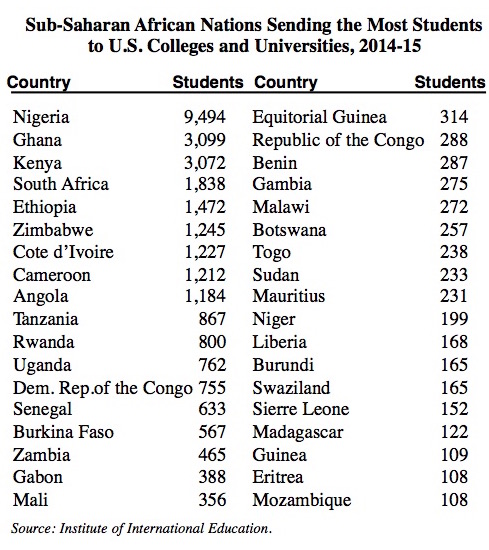
The Institute for International Education reports that in the 2014-15 academic year, there were 33,593 students from sub-Saharan Africa enrolled at colleges and universities in the United States. They made up 3.4 percent of the 974,926 foreign students at U.S. colleges and universities that year. The number of students from sub-Saharan Africa was up 8 percent from the prior year. But due to an overall increase in the number of foreign students of 10 percent, the percentage of all foreign students that were from sub-Saharan Africa decreased from 3.5 percent to 3.4 percent.
Among sub-Saharan African nations, Nigeria in 2014-15 sent the most students to American colleges and universities. That year, there were 9,494 Nigerians studying here, up by nearly 20 percent from a year ago. The increase in the number of students from Nigeria accounts for more than 63 percent of the total increase of students from all sub-Saharan African nations. The number of students from Nigeria is more than triple the number from any other sub-Saharan African nation.
In 2014-15, Ghana ranked second, sending 3,099 students to the United States. Ghana replaced Kenya in second place. Enrollments from Kenya have declined in recent years, including a nearly 4 percent drop this year following a nearly 9 percent drop in the previous year. Kenya still ranked third with 3,072 students at U.S. colleges and universities.
South Africa, Ethiopia, Zimbabwe, Cote d’Ivoire, Cameroon, and Angola each had more than 1,000 students studying in the United States. Tanzania, Uganda, the Democratic Republic of the Congo, and Rwanda all sent at least 700 students to study at U.S. colleges and universities.
All told, 50 nations from sub-Saharan Africa had college students studying in the U.S. during the 2014-15 academic year. Of these, 36 nations sent at least 100 students to U.S. colleges and universities. (See table below.)
Undoubtedly, some of these students from sub-Saharan Africa nations such as Namibia, South Africa, and Zimbabwe are White, but there is no data to report on the racial or ethnic makeup of this group of African students at U.S. colleges and universities.












Noteworthy